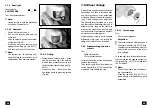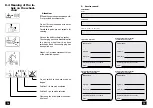
45
44
6.3.1.1 Safety information
!
Attention:
An increased danger of tipping over
exists in the following situations when
crossing an obstacle with the step
climber!
• The seat is tilted.
• Driving with angle-adjusted back-
rest.
• Driving on a rising/falling gradient,
especially without a lap seatbelt.
• Negotiating obstacles at an angle.
• Displacement of the tread point
through lifting of the step climber.
• Additional luggage behind the back-
rest or hanging on one side.
• Driving with too low tyre pressure.
• Operation on uneven and/or loose
surfaces
62
6.3.1.2 Attaching/detaching the
step climber
Insert the spring on the upper side of
the step climber, from below, into the
slot of the support plate of the horizon-
tal beam and secure to the frame with
the securing screw (Fig. 62).
☞
The dismantling is effected in the
reverse sequence.
6.3 Step climber
The step climber (Fig. 61/
➀
) serves
exclusively for the crossing of obstacles.
The step climber can be detached when
its use is not required.
!
Attention:
The step climber may only be used
for crossing firm, immovable obsta-
cles on firm, level surfaces.
• The maximum obstacle height for
the step climber is 11
cm.
6.3.1. Crossing an obstacle
Drive straight onto the obstacle at a low
speed.
The step climber will make contact with
the obstacle first and the impetus will
lift both swivel wheels over the step.
☞
Note:
Drive straight onto the obstacle at a
low speed.
61
1
















































